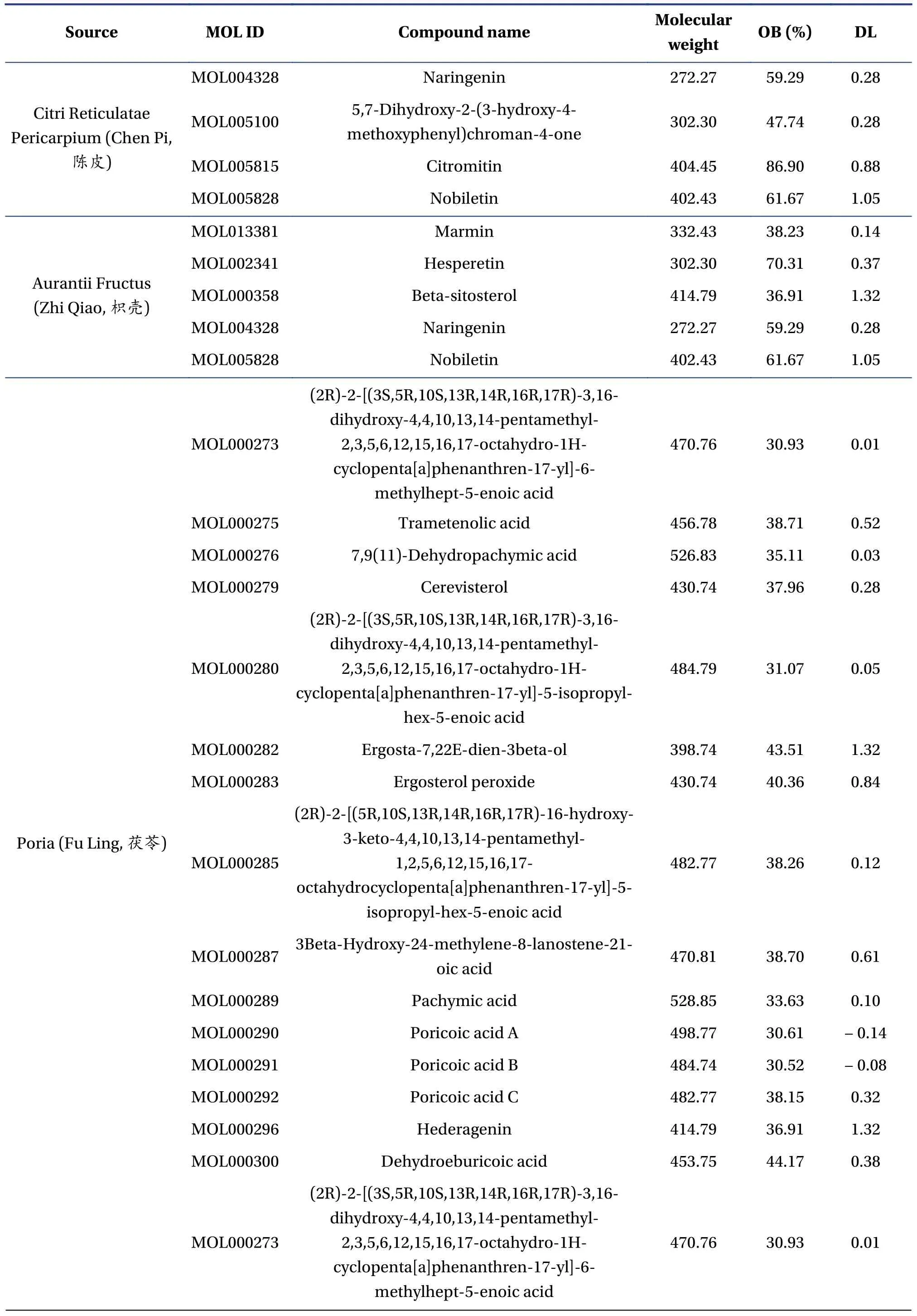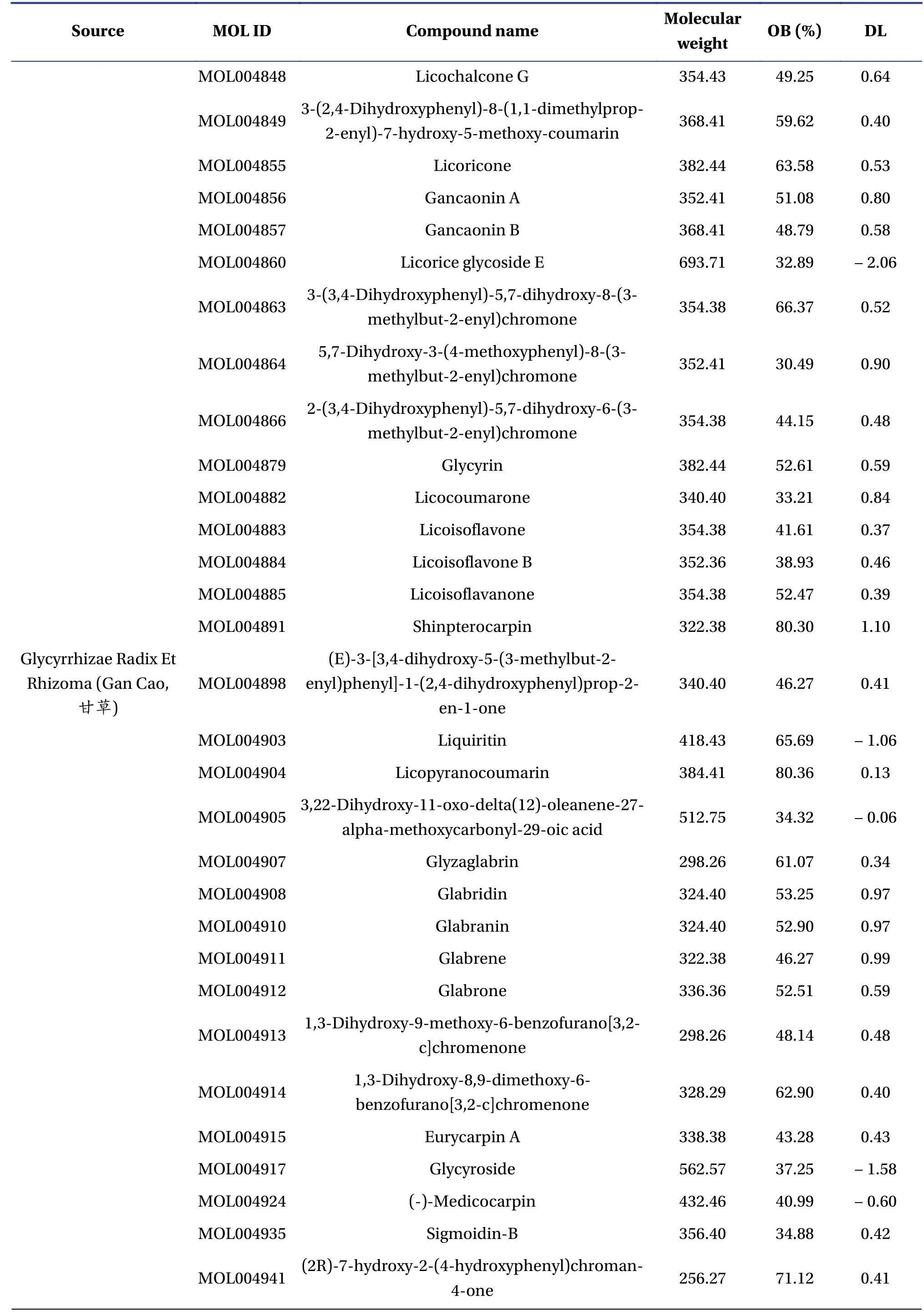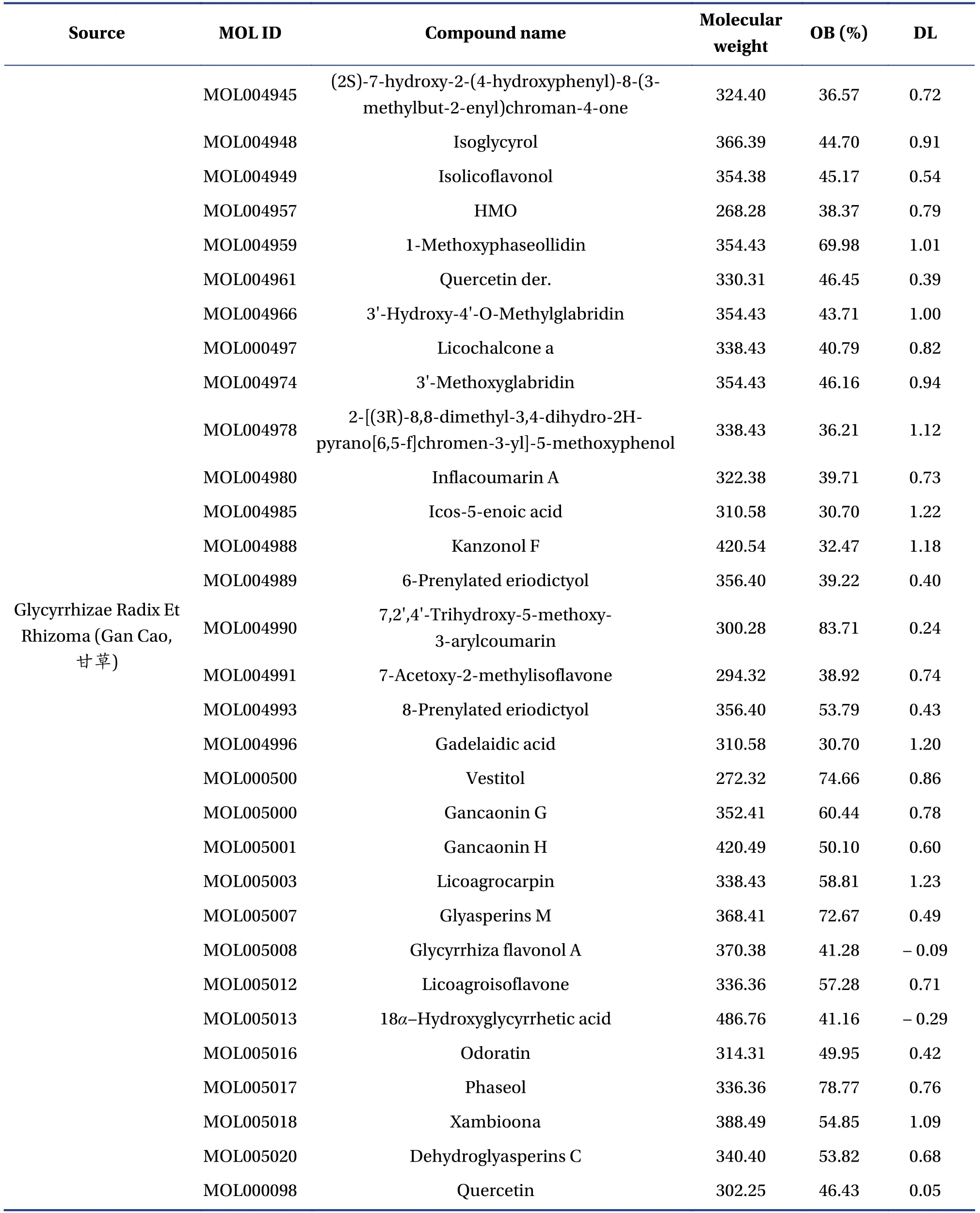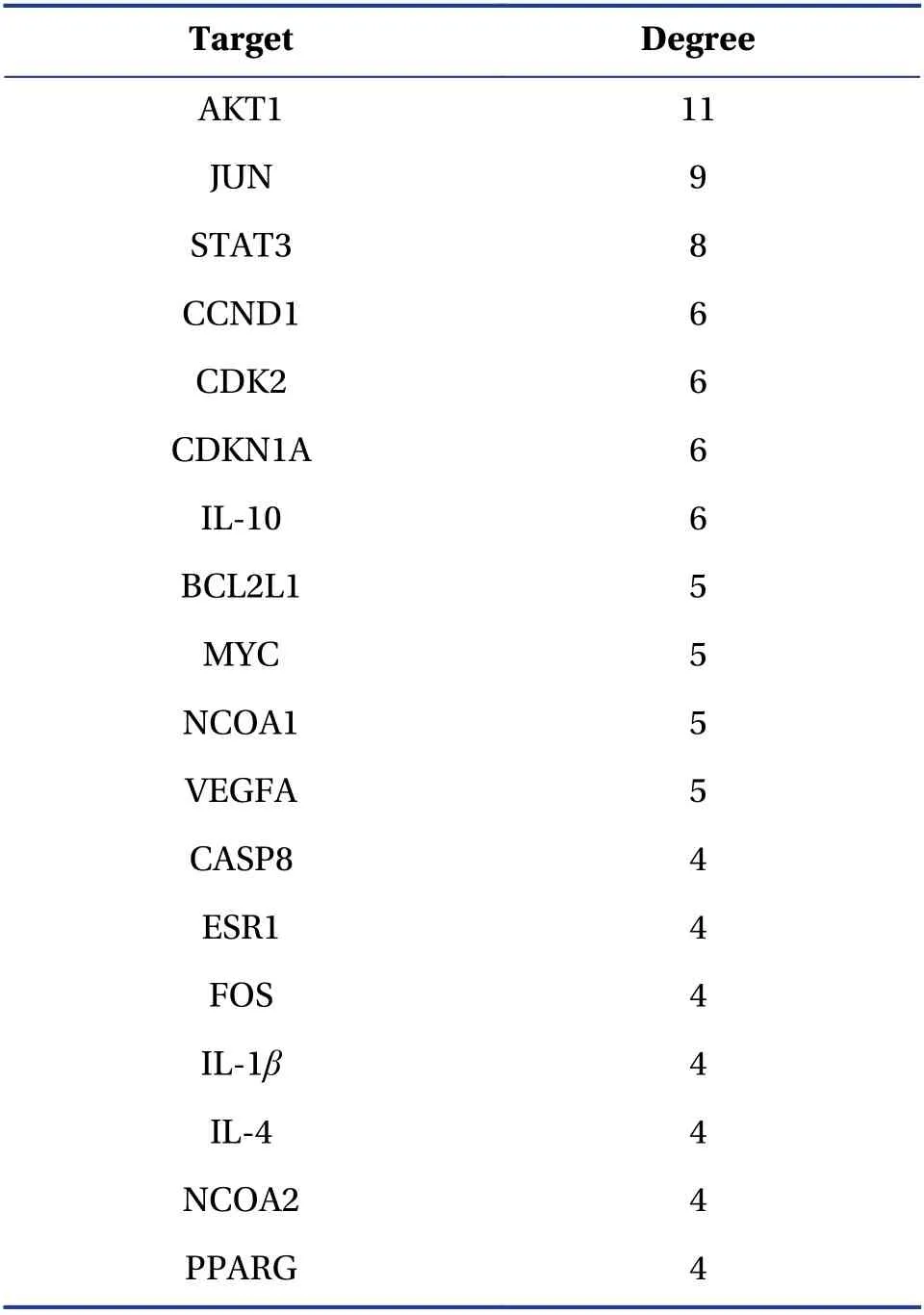A Network Pharmacology Analysis of Cang Fu Dao Tan Formula for the Treatment of Obese Polycystic Ovary Syndrome
2020-11-03CAIMengChengJINYongShengYUChoQinCHENGWen
CAI Meng-Cheng,JIN Yong-Sheng,YU Cho-Qin,CHENG Wen
a.Basic Medical School,Navy Military Medical University,Shanghai 200433,China
b.Department of Pharmacy,Navy Military Medical University,Shanghai 200433,China
c.Department of Traditional Chinese Medicine,Navy Military Medical University,Shanghai 200433,China
Keywords
Cang Fu Dao Tan Formula(CFDTF)
Polycystic ovary syndrome(PCOS)
Network pharmacology
Quercetin
AGE-RAGE signaling pathway
ABSTRACT
Objective To explore the potential molecular targets of Cang Fu Dao Tan Formula(CFDTF)in the treatment of obese polycystic ovary syndrome(PCOS)using network pharmacology and bioinformatic approaches.
Methods The potential blood-entry active compounds and targets of CFDTF were retrieved from the Traditional Chinese Medicine Systems Pharmacology Database and Analysis Platform(TCMSP),and obese PCOS related gene targets were retrieved from GeneCard databases.A protein-protein interaction(PPI)network of CFDTF component-targets and obese PCOS diseasetargets was constructed using STRING.Gene Ontology(GO)and Kyoto Encyclopedia of Genes and Genomes(KEGG)pathway analysis of the intersection network were conducted using a Bioconductor database.
Results In total,114 active compounds were screened according to oral bioavailability(OB)and drug similarity(DL),and 328 targets related to these constituents were obtained.Further,2 559 target genes directly related to obese PCOS were obtained from the GeneCard databases,and 82 genes were obtained from the intersection of the component-target and disease-target PPI network.These genes were mainly involved in response to steroid hormones,nutrient levels and lipopolysaccharide as well as in other biological processes.Their molecular functions were mainly related to nuclear receptor activity,phosphatase binding and cytokine activity,and they were enriched in the cytoplasm,cell membrane and membrane region.
Conclusions CFDTF consists of 114 active compounds that are responsible for its pharmacodynamic effects.It mainly regulates the AGE-RAGE signaling pathway in diabetic complications,bladder cancer,and hepatitis B and in other signaling networks.These findings provide certain theoretical and scientific basis for the treatment of obese PCOS with Chinese medicine.
1 Introduction
Polycystic ovary syndrome(PCOS)is a common endocrine and metabolic disorder in women.Its main clinical manifestations are menstrual disorders,infertility,hirsutism,obesity and metabolic syndrome.A recent research shows that its incidence varies in different regions and ethnic groups,but its incidence rate is generally about 5% - 10%[1].It seriously affects patients’quality of life and financially burdens families and the society.Presently,its pathogenesis is unclear,and it is clinically treated using ethinylestradiol cyproterone(Diane-35),clomiphene,metformin and other drugs.Although these drugs have curative effects,their side effects cannot be avoided.
Cang Fu Dao Tan Formula(CFDTF)contains eight main components,which has been clinically used for 300 years with exact curative effect and has good clinical effect against PCOS[2],including Atractylodis Rhizoma(Cang Zhu,苍术),Cyperi Rhizoma(Xiang Fu,香附),Arisaematis Rhizoma(Tian Nan Xing,天南星),Citri Reticulatae Pericarpium(Chen Pi,陈皮),Aurantii Fructus(Zhi Qiao,枳壳),Poria(Fu Ling,茯苓),Glycyrrhizae Radix Et Rhizoma(Gan Cao,甘草)and Zingiberis Rhizoma Recens(Sheng Jiang,生姜).CFDTF is mainly used in treating phlegm associated with stasis of moisture.Previous studies have proven that CFDTF could activate Qi and reduce phlegm in rats[3-5].However,its complexity has brought about certain difficulties in the systematic study of its pharmacodynamic substance basis and mechanism.
Chinese herb is the material basis of treating diseases in traditional Chinese medicine(TCM),which has multi-target,multi-link and multi-effect characteristics.The development of TCM is limited by its unclear mechanism.Network pharmacology is a new subject that integrates system biology and pharmacology in recent years,and it analyses biological information to reveal the interaction mechanism between drugs and diseases from micro levels.In this study,we excavated the main active compounds and targets of CFDTF and used network pharmacology and bioinformatics to predict its key genes in the treatment of obese PCOS.Moreover,we analyzed the functional enrichment of these genes and studied the key protein-protein interaction(PPI)network,so as to provide clues for the clinical prevention and treatment of obese PCOS,and provide a scientific basis for the promotion and application of TCM or integrated TCM and western medicine in the treatment of obese PCOS.
2 Materials and Methods
2.1 Database
The Traditional Chinese Medicine Systems Pharmacology Database and Analysis Platform(TCMSP,version 2.3,http://lsp.nwu.edu.cn/tcmsp.php)contains large data on formulas and their herbal compounds.We retrieved the compounds and protein targets of CFDTF from TCMSP for further analysis.STRING(version 11.0,https://stringdb.org/)is a functional protein association network.Cytoscape(version 3.6.1,https://cytoscape.org/)is a social network analysis and visualization tool.GeneCard(version 4.5.0,http://www.genecards.org/)and Bioconductor(version 3.6.0,http://www.bioconductor.org)are databases[6].
2.2 Screening the active components and predicting the targets of CFDTF
We entered “cangzhu” “xiangfu” “tiannanxing”“chenpi” “fuling” “zhiqiao” “gancao” and“shengjiang” in the herb name field.All chemical compounds data of CFDTF were searched in the TCMSP database based on absorption,distribution,metabolism and excretion parameters,and the possible active compounds were screened according to the principles of oral bioavailability(OB)≥ 30%and drug similarity(DL)≥ 0.18.The “related targets”module in the TCMSP database was used to predict the target of the active compounds in CFDTF,and Cytoscape software was used to construct the active compound-target network of CFDTF.In the network,nodes represented the molecules and target proteins,and edges represented the interaction between components and targets.
2.3 Retrieval of known genes specifically associated with obese PCOS
“Obese polycystic ovary syndrome” or “obese PCOS”were used as keywords to retrieve known gene targets related to obese PCOS from GeneCard disease databases.
2.4 Gene target analysis of CFDTF in the treatment of obese PCOS
The effective components of drugs exert their effects in the body by directly acting on the target or indirectly acting on other targets.Various complex signal networks regulate the occurrence and prevention of diseases.There are interactions among different signal pathways and signal transduction between upstream and downstream targets.The direct and indirect regulatory relationship between target and target can be clearly displayed by constructing a PPI network.The active compound targets and obese PCOS disease targets of CFDTF were imported into STRING for PPI network drawing.The above two PPI networks were fused by Cytoscape software,and the intersection network was extracted.The direct or indirect targets of CFDTF for obese PCOS treatment were then obtained.
2.5 Gene Ontology(GO)and pathway enrichment analysis of CFDTF in the treatment of obese PCOS
GO is a common method for annotating genes and their expression products.It is mainly divided into three parts:biological process(BP),cell component(CC)and molecular function(MF).We can understand the biological functions,ways or cell localization of drug targets through GO analysis,which can help investigators explore new research directions.Kyoto Encyclopedia of Genes and Genomes(KEGG)can analyze the signaling pathways of drug targets(or differentially expressed genes)in order to understand the signaling pathways that have significantly changed in the course of disease,which is of great significance in exploring the mechanism of action of CFDTF in the treatment of obese PCOS.In this study,R software was used to analyze the GO and KEGG pathway enrichment of CFDTF on the direct or indirect targets of obese PCOS.P<0.05 and FDR<0.05 were set as the critical values of significant gene enrichment.Term and- Log10Pwere used to plot.
3 Results
3.1 Screening of bioactive components from CFDTF
In total,670 chemical constituents of CFDTF were retrieved and screened according to OB and DL.Among them,354 components were OB ≥ 30%,328 were DL ≥ 0.18,and 142 were OB ≥ 30% and DL ≥0.18(Figure 1).After further searching and pairing analysis,114 blood-entry active compounds with corresponding targets were screened out from CFDTF.Glycyrol,citromitin,7,2',4'-trihydroxy-5-methoxy-3-arylcoumarin,licopyranocoumarin and shinpterocarpin had the highest OB values,and(-)-medicocarpin,kanzonol F,xambioona,isoglycyrol and dehydroeburicoic acid had the highest DL values(Table 1).
3.2 Targets retrieval results related to obese PCOS and their representation on a Venn map
2 559 targets were retrieved from GeneCard databases.To draw a Venn map,they were inputted into the R software,along with 229 drug composition targets and 159 common targets were obtained after their intersection(Figure 2).
3.3 Prediction of action targets of CFDTF and visual analysis of bioactive compound-target network
The TCMSP database was used to retrieve the targets of CFDTF’s active compounds.After eliminating the repetitive targets,159 predictive genes were obtained.Cytoscape 3.6.1 was used to visualize the active compound-targets network and draw the network diagram.As shown in Figure 3,there were 1 207 correlations between the active compounds of CFDTF and their corresponding targets.Among all the chemical compounds,quercetin had the highest number of targets(102),and among all the targets,PTGS2 was most acted upon(99 chemical components acted on it)(Table 2).
3.4 Construction of a PPI network of target genes for CFDTF in the treatment of obese PCOS
A PPI network(Figure 4)was constructed using string software.The species selected wereHomo sapienswith confidence > 0.99.There are 82 nodes and 204
edges in the PPI notework,nodes representing targets and edges representing PPI.According to the degree of nodes,the graph of 18 key nodes such as AKT1,JUN and STAT3,was drawn by STRING statistical function(Table 3).Among all the targets,AKT1 had the most targets,reaching 102.

Table 1 Bioactive compounds of CFDTF screened by ADME parameters

Table 1 Continued

Table 1 Continued

Table 1 Continued

Table 1 Continued
3.5 Analysis of GO function enrichment of CFDTF in the treatment of obese PCOS
The mechanism of CFDTF in the treatment of obese PCOS mainly involved response to steroid hormone,nutrient levels,lipopolysaccharide,antibiotic,metal ion,alcohol,acid chemical,oxidative stress,nutrient,oxygen levels and other biological processes.The molecular functions included nuclear receptor activity,phosphatase binding,cytokine activity,cytokine receptor binding,steroid hormone receptor activity,protein phosphatase binding,nuclear hormone receptor binding,protease binding,MAP kinase activity and hormone receptor binding.It was enriched in the intracellular region,membrane raft,membrane microdomain,membrane region,caveola,plasma membrane raft,nuclear chromatin,vesicle lumen,cytoplasmic vesicle lumen,nuclear transcription factor complex and nuclear receptor activity(Figure 5).

Table 2 Network of main compound-targets and their topological properties
3.6 Analysis of KEGG pathway enrichment of CFDTF in the treatment of obese PCOS
As depicted in Figure 6,the molecular mechanism of CFDTF in the treatment of obese PCOS mainly involved the following 20 key signaling pathways:AGE-RAGE signaling pathway in diabetic complications,bladder cancer,hepatitis B,fluid shear stress and atherosclerosis,Kaposi sarcomaassociated heobese herpesvirus infection,endocrine resistance,prostate cancer,proteoglycans in cancer,pancreatic cancer,non-small cell lung cancer,EGFR tyrosine kinase inhibitor resistance,IL-17 signaling pathway,HIF-1 signaling pathway,hepatitis C,human cytomegalovirus infection,TNF signaling pathway,colorectal cancer,VEGF signaling pathway,relaxin signaling pathway and platinum drug resistance.

Table 3 Key targets of the PPI network
4 Discussion
PCOS is a common endocrine and metabolic disorder in women.Its etiology is closely related to hereditary,environmental and organismal factors.Its pathogenesis is the inability to select the dominant follicles in polycystic ovary.This phenomenon stops the growth of most follicles and causes them to get together,leading to anovulation[7].Besides its association with endocrine dysfunction regulated by the hypothalamus-pituitary-ovary axis,it also causes compensatory hyperinsulinemia in patients[8].Modern medicine,which only treats symptoms and ignores the root of the disease,focuses on weight loss,androgen reduction and ovulation induction.
PCOS is associated with “oligomenorrhea” “late menstruation” “metrorrhagia” “amenorrhea” and“infertility” in TCM,which are closely related to the dysfunction of the spleen,liver and kidney,and its etiologies are closely related to dampness,phlegm and blood stasis.As the spleen,liver and kidney govern transport essence,dispersing emotion,store essence,respectively,their dysfunction obstructs the normal transport of Qi,blood and body fluid,causing them to stagnate and block the Chong and Ren two collateral channels,which leads to the development of PCOS[9].Clinically,PCOS patients mainly show phlegm associated with stasis of moisture syndrome,which is principally treated by invigorating spleen to dissipate phlegm.Modern medicine believes that insulin resistance caused by intestinal flora imbalance is an important mechanism of PCOS.The functions of intestinal flora,including enhancing immunity and promoting digestion,absorption and excretion,are similar to those of the spleen,which resist external evils and transports water and grain essence.Phlegm dampness caused by spleen dysfunction is an important basis of PCOS.In addition,phlegm dampness patients showed metabolic disorder and hyperinflammation,which coincided with the understanding of PCOS in modern medicine.Although modern research shows that CFDTF can significantly regulate the intestinal flora,metabolism of glucose and lipid,and rate of ovulation and pregnancy,its mechanism is still unclear[10-12].
On screening of active compounds,flavonoids such as quercetin,luteolin,kaempferol,wogonin and naringenin,were identified in the CFDTF.Flavonoids have many pharmacological effects such as antioxidative,anti-inflammatory and fat metabolism regulatory effects[13].A research shows that flavonoids have good effects on PCOS.Epimedium flavonoid can ameliorate hyperandrogenemia,regulate luteinizing hormone and follicle stimulating hormone ratio,increase serum estrogen and improve ovarian function[14].Dodder flavonoid can protect PCOS rats induced with DHEA combined with HCG[15].In GO enrichment analysis,screened compounds demonstrated the correlation with the response to steroid hormone,nutrient levels,lipopolysaccharide and antibiotic.Recent research showed positive correlations between the risk of abnormal glucose metabolism and serum aldosterone,androstenedione,oestrone and other steroid hormone[16].Modern medicine also uses steroids hormone to treat PCOS.Nutritional intervention can regulate the hormone secretion and glucose metabolism level,reduce the weight and insulin resistance,and improve ovarian function and the success rate of ovulation and conception of patients with obese PCOS[17].Furthermore,paradoxical inflammatory responses involving lipopolysaccharide in mononuclear cells of obese women with PCOS are linked to hyperandrogenism[18],which confirms the results of network pharmacology.The KEGG pathway analysis indicated that they focused on the AGE-RAGE signaling pathway in diabetic complications,endocrine resistance,IL-17 signaling pathway,TNF signaling pathway,HIF-1 signaling pathway,etc.Insulin resistance can lead to the increase of ovarian volume and affect ovarian morphology and endocrine function[19].Studies have shown that the AGE-RAGE signaling pathway in insulin resistance was significantly differentially expressed in normal and obese PCOS patients.Regulating AKT may be an effective strategy for the treatment of obese PCOS[20,21],as AKTs have been confirmed to play an important role in granulosa-lutein cell proliferation,and there is reciprocal feedback between AKT and androgen[22].Moreover,studies have shown that the MAPK signaling pathway plays an important role in ovarian granulosa cell proliferation[23].Prolactin is a polypeptide hormone secreted by the pituitary gland that regulates the female reproductive and endocrine system by activating pathways,including the MAPK pathways[24].It has also been reported that MAPK and NF-κB could effectively regulate endocrine and insulin resistance,which was one of the important ways to treat obese PCOS[25-27].Moreover,inflammation triggered by saturated fat ingestion is linked to insulin resistance and hyperandrogenism in PCOS[28].A previous study revealed that hypoxia-inducible factor-1 mediated endothelin-2 signaling plays an important role in ovulation in rats,and indicated that HIF-1 signaling was inhibited in a PCOS rat model by increasing proline hydroxylase activity[29].Network pharmacology analysis results supported the clinical application of CFDTF in PCOS.
In conclusion,the results of this study indicated that CFDTF contains 114 main components,including quercetin,luteolin,kaempferol,wogonin and naringenin,etc.The mechanism in the treatment of obese PCOS involved regulation of the AGE-RAGE signaling pathway in diabetic complications,endocrine resistance,IL-17 signaling pathway,TNF signaling pathway,HIF-1 signaling pathway,etc.Its key targets included AKT1,JUN,STAT3,CCND1,CDK2,CDKN1A,IL-10,etc.Its pharmacological action showed the characteristics of multi-component,multi-pathway and multi-target.This research is expected to provide a preliminary basis for clinical or basic research on the treatment of obese PCOS with TCM that invigorates spleen to dissipate phlegm,and provide a scientific basis for clinical application of TCM combined therapy in the treatment of obese PCOS.
Acknowledgements
We thank for the funding support from the the Scientific Research Projects of Shanghai Science and Technology Commission(No.19401930200).
Competing Interests
The authors declare no conflict of interest.
猜你喜欢
杂志排行
Digital Chinese Medicine的其它文章
- Instructions for Authors
- A Preliminary Study on Legitimacy Identification Standards for Unconventional Treatment Technologies in Traditional Chinese Medicine
- A Metabolomics Study of the Volatile Oil from Prunella vulgaris L.on Pelvic Inflammatory Disease
- Fermentation Production of Ganoderma lucidum by Bacillus subtilis Ameliorated Ceftriaxone-induced Intestinal Dysbiosis and Improved Intestinal Mucosal Barrier Function in Mice
- Antioxidant,Antimicrobial and Wound Healing Potential of Helicteres isora Linn.Leaf Extracts
- Qualitative and Quantitative Analysis of Linoleic Acid in Polygonati Rhizoma
